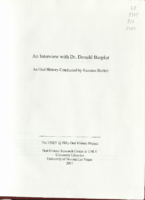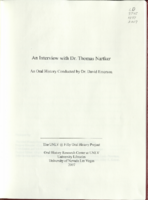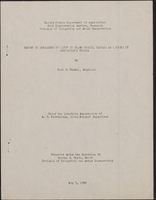Search the Special Collections and Archives Portal
Search Results
First Methodist Church of Las Vegas Photograph Collection
Identifier
Abstract
The First Methodist Church Photograph Collection (approximately 1909-1912) contains black-and-white photographic prints and corresponding negatives of the Las Vegas train depot, railroad yards, and the First Methodist Church in Las Vegas, Nevada. Also included are portraits of Reverend Edwin A. Palmer and his family.
Archival Collection
Edward Joseph Deck Photograph Collection
Identifier
Abstract
The Edward Joseph Deck Photograph Collection (approximately 1870-1920) consists of photographic prints and negatives of Edward Joseph Deck and other miners in Pioche, Nevada and various locations around the townsite. There are also images of ranches, mills, and mill workers both in and outside of the Pioche townsite.
Archival Collection
Nino Maurizi Photograph Collection
Identifier
Abstract
The Nino Maurizi Photograph Collection consists of two black-and-white photographic prints and corresponding negatives of Nino Maurizi at the Mount Charleston Camp for the Las Vegas Army Air Field in 1943. Images depict Maurizi standing at the entrance of Mount Charleston Camp as well as inside the camp.
Archival Collection
Esther Ruth Peaslee Postcard Collection
Identifier
Abstract
The Esther Ruth Peaslee Postcard Collection (approximately 1900-1983) consists of postcards and postcard reproductions depicting a Labor Day celebration in Goldfield, Nevada, the Angelus Hotel, and the Goldfield Hotel. The reproductions were made approximately between 1960 and 1983. Also included is a postcard showcasing scenes in Goldfield.
Archival Collection
Stuart A. McCarthy Photograph Collection
Identifier
Abstract
The Stuart A. McCarthy Photograph Collection (approximately 1940-1949) consists of photographic prints and negatives of the Photo Mart storefront on Fremont Street as well as a view of the Golden Nugget, Eldorado Club, Hotel Apache, Boulder Club, and the Pioneer Club on Fremont Street in Las Vegas, Nevada.
Archival Collection
Theodore M. Parsons Photograph Collection
Identifier
Abstract
The Theodore M. Parsons Photograph Collection (1936-1988) consists of photographic prints and negatives depicting Theodore M. Parsons and other Civilian Conservation Corps (CCC) workers in Boulder City, Nevada between 1936 and 1942. There are individual images of Parsons as well as group photographs of workers at CCC camps and public gatherings.
Archival Collection

Transcript of interview with Dr. Donald Baepler by Suzanne Becker, April 23, 2007
Date
Archival Collection
Description
Text

Transcript of interview with Dr. Thomas Nartker by Dr. David Emerson, November 13, 2006
Date
Archival Collection
Description
Text

Transcript of interview with Ronald Simone by Claytee White, May 5, 2009
Date
Archival Collection
Description
Musician Ronald Simone of Las Vegas credits his father’s guidance and his upbringing in New Haven, Connecticut, for shaping his musical and educational aspirations. Due to its proximity to New York City and the influence of Yale University, New Haven offered its residents the finest in musical entertainment; as a result, many musical greats were from or had lived in New Haven and most Broadway shows opened at New Haven’s Shubert Theater. Born in 1935 with the gift of perfect pitch, Simone began to play the piano at a young age and could play most pieces by ear. He began playing professionally at age eight in 1943 with a weekly stint on a radio show, Kitty's Revue. Still in grade school during World War II he began touring locally with an amateur producer, who formed a show that played military bases and hospitals around Connecticut and into New York and Massachusetts. In high school Simone formed his own trio and a quartet and played piano in gin mills, illegal card rooms, and resorts in upstate New York while playing trumpet in the high school band. He joined the Musicians Union at 18 and continued to play in New York and Connecticut clubs and theaters throughout his five years at Yale. During his second year at Yale the School of Music became a graduate school, from which Ron graduated in 1958. Ron’s sister Louise married one of his Yale classmates, a drummer, and the couple moved to Las Vegas. Ron visited his sister in 1959, loved the musical opportunities he saw, transferred his Musicians Union membership, and moved to Las Vegas with his friend, violinist Joe Mack, in September 1960. After sub work and playing a lounge show at the Riviera, he spent five and a half years in the Riviera showroom, moving in 1966 to the Desert Inn, where he played piano in the exclusive Monte Carlo Room for five years for the likes of Dean Martin, Sandy Koufax, Sammy Davis Jr., and Kirk Kerkorian. From there Simone went to the Dunes, where he remained for the next nineteen years working with choreographer Ronnie Lewis and rehearsing and playing all the Casino de Paris shows, line numbers, and production numbers. In July 1989, Musicians Local 369 went on strike. Because Simone was playing the Follies Bergere at the Tropicana—the first house band to strike—he was among the first musicians to walk out. Musicians at all but three Strip hotels (Circus Circus, Riviera, and the Stardust) followed. While the musicians strike lasted nearly eight months, Simone was recruited for sanctioned sub work for the duration at the Lido de Paris show at the Stardust. After the strike ended he worked with Johnny Haig's relief band playing six nights a week at various hotels.
Text

Report on water spreading in Clark County, Nevada as a means of controlling floods, May 9, 1949
Date
Archival Collection
Description
Report on the efficacy of water spreading to disperse flood water in Southern Nevada. Under the immediate Supervision of A. T. Mitchelson, State Project Supervisor. Prepared under the direction of George D. Clyde, Chief, Division of Irrigation and Water Conservation
Text
